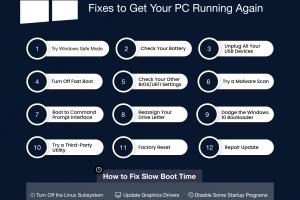Ultimate Guide to Fixing a PC That Won't Boot: Troubleshooting Tips & Tricks

-
Quick Links:
- Introduction
- Understanding the Boot Process
- Common Boot Issues
- Step-by-Step Troubleshooting
- Advanced Troubleshooting Techniques
- Case Studies
- Expert Insights
- FAQs
Introduction
Encountering a PC that won't boot can be a frustrating experience, whether you're a casual user or a seasoned tech enthusiast. The inability to start your computer can result from various factors, including hardware malfunctions, software conflicts, or even BIOS issues. This guide will walk you through the necessary steps to diagnose and fix boot problems effectively.
Understanding the Boot Process
The boot process is the sequence of events that occurs from the moment you power on your PC until the operating system is fully loaded. It involves several critical stages:
- Power-On Self Test (POST): The initial check for hardware components.
- BIOS/UEFI Initialization: Basic Input/Output System or Unified Extensible Firmware Interface settings are loaded.
- Bootloader Execution: The bootloader loads the operating system.
Understanding this process helps you pinpoint where the failure is occurring. For instance, if you hear beeping sounds, it indicates a hardware issue detected during the POST phase.
Common Boot Issues
Here are some of the most frequent issues that can prevent a PC from booting:
- Dead Power Supply: The most common culprit when a PC doesn’t power on at all.
- Loose or Damaged Hardware: Components such as RAM, graphics cards, or hard drives may be improperly connected.
- Corrupted Operating System: If your OS files are damaged, the system may fail to boot.
- BIOS Configuration Issues: Incorrect BIOS settings can prevent booting.
- External Device Conflicts: Peripherals can sometimes interfere with the boot process.
Step-by-Step Troubleshooting
To effectively troubleshoot a PC that won't boot, follow these structured steps:
Step 1: Check Power Supply
Begin by ensuring that your PC is receiving power. Check the power cable, power outlet, and verify that the power supply unit (PSU) is functioning properly.
Step 2: Inspect Hardware Connections
Open your PC case and reseat all components:
- Remove and reinsert RAM sticks.
- Ensure the graphics card is properly seated.
- Check all power connectors.
Step 3: Remove External Devices
Disconnect all external devices except for the keyboard and monitor. This isolates potential conflicts from USB devices.
Step 4: Access BIOS/UEFI
Try booting into BIOS by pressing the designated key (usually F2, DEL, or ESC) right after powering on. From there, you can check hardware settings and ensure the correct boot order.
Step 5: Boot in Safe Mode
If the system starts but doesn't load Windows, try booting into Safe Mode:
- Restart and repeatedly press F8.
- Select 'Safe Mode' from the menu.
Step 6: Repair or Reinstall the Operating System
If you suspect a corrupted OS, consider using installation media to repair or reinstall Windows. Follow the prompts to perform necessary repairs.
Advanced Troubleshooting Techniques
If the basic troubleshooting steps do not resolve your issue, consider the following advanced techniques:
Using Recovery Tools
Windows and other operating systems come with recovery tools that can help repair boot issues:
- Startup Repair: Automatically fixes some problems that prevent Windows from starting.
- System Restore: Restores the PC to a previous state.
Checking Hard Drive Health
Use diagnostic tools to check the health of your hard drive. Tools like CrystalDiskInfo can provide insight into potential failures.
Testing RAM
Use tools such as MemTest86 to check for faulty RAM that could be causing boot issues.
Case Studies
Here are a couple of real-world scenarios where troubleshooting steps resolved boot issues:
Case Study 1: Corrupted Boot Files
A user faced a "Missing Operating System" error. After attempting various steps, they used Windows installation media to access the repair options and successfully repaired the boot files.
Case Study 2: Faulty Power Supply
Another case involved a PC that showed no signs of life. After testing the power supply with a multimeter, it was determined to be faulty. Replacing it resolved the issue.
Expert Insights
Experts suggest keeping your system updated and regularly checking hardware connections to avoid boot issues. Furthermore, maintaining backups ensures that data is safe, even if a complete system failure occurs.
FAQs
1. What causes a PC not to boot?
A PC may fail to boot due to power supply issues, hardware malfunctions, corrupted operating systems, or BIOS misconfigurations.
2. How can I tell if my power supply is dead?
If the computer does not power on at all, or if the fans do not spin, the power supply may be the issue. Testing with a multimeter can confirm this.
3. Can I fix a corrupted operating system?
Yes, you can use recovery tools or installation media to repair corrupted boot files or reinstall the OS if necessary.
4. What is the first thing to check when a PC won't boot?
Start with the power supply to ensure the system is receiving adequate power.
5. Is it safe to open my PC to check hardware connections?
Yes, as long as the PC is powered off and unplugged. Ensure you follow proper ESD precautions.
6. How can I troubleshoot BIOS issues?
Try resetting the BIOS to default settings or updating it to the latest version from the manufacturer's website.
7. What if my PC turns on but won't load Windows?
Attempt to boot into Safe Mode or use recovery options to troubleshoot the issue further.
8. Can external devices cause boot issues?
Yes, peripherals like USB drives or external hard drives can sometimes interfere with the boot process.
9. How do I know if my RAM is faulty?
Use diagnostic tools like MemTest86 to test for errors in RAM.
10. Should I seek professional help if my PC won't boot?
If you’ve exhausted all troubleshooting steps and the issue persists, it may be wise to consult a professional technician.
Random Reads